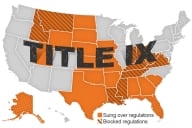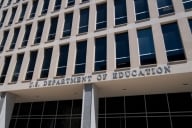You have /5 articles left.
Sign up for a free account or log in.

University of Pennsylvania students take a break while distributing packets to request mail-in ballots.
Courtesy of Michael Nevett
Back in the comparatively stress-free days of February -- when George Floyd and Ruth Bader Ginsburg were still alive and the coronavirus was a worry on a distant continent -- Roderick Hart, a junior at Morehouse College in Atlanta, would get up at six every morning to campaign for Joe Biden.
He’d pack into a Fiat with other supporters of the now Democratic presidential nominee, maskless and drinking coffee, to go wave signs on a street corner.
On a road trip to Iowa in advance of that state’s Democratic caucus, they’d knock on doors, shake hands with the people who answered and be invited in, back when things like that still used to happen.
Then the pandemic came. “And everything changed,” Hart said after volunteering in a text bank, which is like a phone bank, but people send texts. In a most unusual election year, he's standing by himself in his family's kitchen in Maryland texting people in Georgia to remind them to make preparations for voting.
“I don’t usually cry, but I’ve cried three times this year,” he said -- once after Floyd’s death and again when Kamala Harris, a graduate of Howard University, a historically Black college like Morehouse, accepted the Democratic vice presidential nomination. Then again when Ginsburg died.
Thirty-some days before the election, emotions are running high. Polls show younger voters, including college students, are planning to vote in far higher numbers than in the last presidential election. Adding to the fervor is the likely chance that the presidential election will come down to a few thousand votes in a handful of states, like Georgia, where an Atlanta Journal-Constitution poll last week found Trump and Biden are tied, and a large vote on campuses could be pivotal in the outcome. And in a bad sign for President Donald Trump, polls signal that more younger voters could vote for Democrat Joe Biden in larger numbers than they did for Hillary Clinton in 2016.
But this is a year when not much is like the way things were, and the fervor on campuses isn't apparent in the usual chanting throngs of students chanting “four more years” or “yes, we can.” Instead the emotion of the campaign is being expressed through the silent thumbs-up or clapping emojis appearing on the screens at Zoom campaign rallies, said Michael Nevett, a junior studying political science at the University of Pennsylvania and a member of the executive board for the student group UPenn for Biden.
Another way to express their excitement is “looking engaged with the camera on,” he said.
“It’s almost entirely virtual. It’s definitely a change from 2016,” Nevett said.
Two years ago he volunteered for the Pennsylvania Democratic Party during the midterm congressional elections.
“I remember standing on the main walkway on campus four hours a day, five days a week. That’s not happening this year,” he said.
He’d gone to see former president Obama campaign for Democratic candidates at a music amphitheater in Philadelphia, speaking with red, white and blue bunting behind him. This year, Nevett watched Cory Booker, the progressive Democratic senator from New Jersey and onetime presidential candidate, on a Biden Zoom rally. Booker was in a suit. He seemed to be sitting at home, Nevett said, but it was hard to tell.
In Ann Arbor, Mich., the leaves are turning, as they do this time of year, and there are tables of voter registration information on the Diag, at the center of the University of Michigan campus.
During the state’s Democratic primary in March, Biden supporters would debate students backing Bernie Sanders at the tables, said Andrew Scheffler, a sophomore studying political science who co-founded the campus’s pro-Biden group.
Masked volunteers now stand a few feet away from the table. “It’s a combination of we don’t want to get close to them and they don’t want to get close to us,” he said. “And people don’t stick around and have conversations.”
And, at a time when some campuses are barren, the students can be campaigning thousands of miles from their schools.
Morehouse is offering only online classes. Hart this week was standing at the kitchen counter of his parents’ home in Silver Spring, Md., volunteering to text voters back in Georgia to make a plan for voting.
The process involves signing on to a campaign website and texting a script to potential voters. “Instead of going to a campaign office or somebody’s apartment, it means taking things into your own hands and going to the website,” he said.
The weirdness of an election in the year of the pandemic, however, doesn’t appear to be dampening a surge in enthusiasm. But worries also loom over what might happen before Election Day.
It’s still unclear whether more younger voters will be registered in this year’s election than in 2016. The availability of voter registration data is spotty. However, Abby Kiesa, who serves as a liaison between Tufts University’s Center for Information and Research on Civic Learning and Engagement and community groups, is “cautiously optimistic” that come November, the number of young people registered to vote will have increased.
Already in 20 states, the number of people aged 18 to 24 who are registered to vote is higher than it was on Election Day four years ago, says the center, which is tracking the numbers. In Vermont, a third more younger voters are already registered than just before the 2016 election, while there are 28 percent more younger voters in Georgia and 26 percent more in New Jersey.
In addition to more younger voters being registered, more of them are planning to vote this time. Sixty-three percent of 18- to 29-year-olds polled by the Harvard Kennedy School’s Institute of Politics in late August and early September said they will “definitely be voting” in November -- an increase from the 47 percent who said the same in the institute’s poll four years ago.
Seventy percent of college students in a Knight Foundation/College Pulse survey last month said they are “absolutely certain” that they will vote in November.
In Ann Arbor, streams of students have been going into a voting office in the campus’s art museum to make sure they were registered, Scheffler said, even though early voting at the museum polling site didn’t begin until last Thursday.
“Trump won Pennsylvania by 44,000 votes,” Nevett said. “Who knows how close it’s going to be? We want to make sure everybody votes or else this could be decided by a court case or a recount.”
For Hart, the stakes rose with the nomination of Harris as Biden’s running mate. Hart said his mother also graduated from Howard. Hart’s mother, aunt and grandmother, like Harris, were members of the Black Alpha Kappa Alpha sorority. “It’s like seeing my mother, my grandmother and my aunt in her,” he said.
An increase in voting by college students over four years ago could be a problem for Trump. A number of polls are finding that a greater percentage of younger voters are planning to support Biden than were backing Hillary Clinton in 2016, when she narrowly lost to Trump.
Clinton received the support of 55 percent of younger voters, according to the Tufts center's poll in November 2016. Thirty-three percent backed Trump, while others voted for third-party candidates.
A poll in May and June by the center found 58 percent of the younger voters supported Biden, while support for Trump had dropped to 24 percent.
The Harvard Institute of Politics in 2016 found that 49 percent of younger voters backed Clinton. Its poll this spring found 60 percent in the age group supporting Biden. Twenty-seven percent in this year’s poll supported Trump.
The Knight Foundation survey also found Biden has a wide lead among younger voters -- 70 percent to 18 percent.
The Tufts poll this year also found "shaky” support even from young Trump supporters, who “are feeling more disillusioned and less engaged in the 2020 election than Biden-supporting youth.”
Eight percent of younger voters who supported Trump in 2016 were planning to support Biden this time, the poll found.
Even among the young Trump supporters, 69 percent said they disapproved of the president’s performance. Nearly half, 42 percent, of young Trump supporters rated Trump’s response to the coronavirus pandemic at three or lower on a scale of one to five, with one being the lowest.
Groups including the Young Republicans National Federation did not return press inquiries. Turning Point Action, a conservative political group that runs Students for Trump, was unavailable for comment over several days last week. Several organizers and campus presidents of the groups supporting Trump did not respond to requests for interviews.
According to its website, Students for Trump has been holding in-person rallies on Saturdays to “hear from guest speakers, and get trained to knock on thousands of doors in the area,” including ones scheduled this week in Flagstaff, Ariz., and at unannounced locations in Georgia and Iowa in October.
Samantha Zager, the Trump campaign's deputy national press secretary, said, however, the campaign has “a robust network of student supporters and is constantly identifying new voters ahead of November’s election. As Joe Biden and the Democrats seek to keep schools closed this year, our youth engagement efforts will continue both virtually and in person, and we will expand the base of young voters for President Trump -- because if there is one thing the youth of America cannot afford, it’s a Joe Biden presidency.”
Young Trump supporters likely played a role in helping Trump win the razor-thin races in some states that put him over the top four years ago. The opposite could happen this time, said Tufts’ Kiesa.
“Look at Wisconsin and Michigan and how close the election was,” she said.
However, at the University of Pennsylvania campus, Nevett and other volunteers two weekends ago dropped off packets at homes, with stamps and forms to mail in to receive absentee ballots.
Among the concerns being raised by a number of voting rights groups are a cacophony of laws around voting affecting students that, despite the excitement, could put up barriers to students voting.
Pennsylvania allows most voters to go online to request ballots be sent, but not those using student IDs. They have to mail in their requests. Nevett is concerned about a Pennsylvania Supreme Court ruling that said mail-in ballots have to be inside an unmarked security envelope in order to be counted.
“In January, I was giving talks to college and university presidents telling them not to worry about 2020, that they only need to worry about 2022,” Nancy L. Thomas, director of the Institute for Democracy and Higher Education at Tufts, told Inside Higher Ed last month about the barriers. “Then COVID hit and I realized immediately that election laws and rules were all going to be a muddle-y mess and there would be lots of efforts to disenfranchise certain groups, including college students.” Thomas last month co-wrote a report to college administrators on how to encourage student voting.
Nevett also worried about a COVID outbreak keeping students planning on voting in person from going to the polls. “What happens if you get sick on Election Day?” he said. “Maybe someone around you tests positive, or there’s a big outbreak and all these people have to be quarantined?”
Brent J. Cohen, executive director of Generation Progress, a youth advocacy group associated with the left-of-center Center for American Progress that has been running an online voter registration drive, worried as well. He cited the University of Georgia’s initial decision to close polling places on campus before backtracking.
“We don’t know if there will be more,” he said.
“What gives me hope is how incredibly motivated young people are to make sure their voices are heard clearly and loudly,” he said.








